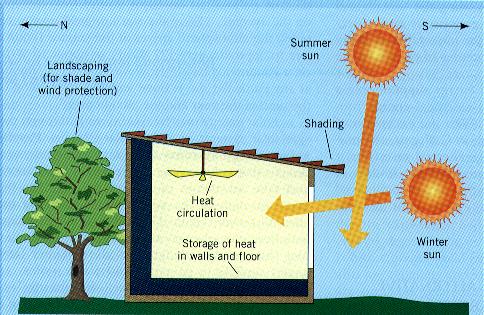Passive energy is used in sustainable architechture to make use of natural energy sources and local climate. It's used in energy efficient houses such as Zero-energy buildings and Low-energy houses. The most used is use passive solar energy, which is different from active solar energy which must be collected through solar panels or other devices in order to become useful.
The point is to use the maximum of available energy sources that surround the house. The special architectural solutions are used to heat the house in the winter and release heat in the summer.

Passive energy can be used in conjunction with other sustainable solutions such as thermal isolation.

Advantages
- isolation for building owners from future energy price increases
- increased comfort due to more-uniform interior temperatures (this can be demonstrated with comparative isotherm maps)
- reduced requirement for energy austerity
- reduced total cost of ownership due to improved energy efficiency
- reduced total net monthly cost of living
- improved reliability - photovoltaic systems have 25-year warranties - seldom fail during weather problems - the 1982 photovoltaic systems on the Walt Disney World EPCOT Energy Pavilion are still working fine today, after going through 3 recent hurricanes
- extra cost is minimized for new construction compared to an afterthought retrofit
- higher resale value as potential owners demand more ZEBs than available supply
- the value of a ZEB building relative to similar conventional building should increase every time energy costs increase
- future legislative restrictions, and carbon emission taxes/penalties may force expensive retrofits to inefficient buildings
Disadvantages
- initial costs can be higher - effort required to understand, apply, and qualify for ZEB subsidies
- very few designers or builders have the necessary skills or experience to build ZEBs
- possible declines in future utility company renewable energy costs may lessen the value of capital invested in energy efficiency
- new photovoltaic solar cells equipment technology price has been falling at roughly 17% per year - It will lessen the value of capital invested in a solar electric generating system - Current subsidies will be phased out as photovoltaic mass production lowers future price
- challenge to recover higher initial costs on resale of building - appraisers are uninformed - their models do not consider energy
- while the individual house may use an average of net zero energy over a year, it may demand energy at the time when peak demand for the grid occurs. In such a case, the capacity of the grid must still provide electricity to all loads. Therefore, a ZEB may not reduce the required power plant capacity.
- without an optimised thermal envelope the embodied energy, heating and cooling energy and resource usage is higher than needed. ZEB by definition do not mandate a minimum heating and cooling performance level thus allowing oversized renewable energy systems to fill the energy gap.
- solar energy capture using the house envelope only works in locations unobstructed from the South. The solar energy capture cannot be optimized in South (for northern hemisphere, or North for southern Hemisphere) facing shade or wooded surroundings.





